
After considerable delay while I mixed in other things, here is the final (probably) segment on the Adventure Team Near Space Vehicle, a model rocket designed to launch a 3 3/4" GI Joe (or compatible) Astronaut in Adventure Team style. Today's installment covers launch-pad, flight, and recovery pictures.
First, one more shot of "Captain Lanard" as we prepare the night before the launch. What a go getter! Already suited up and ready to go! Note the tiny Adventure Team astronaut patches on his chest and shoulder.
The launch was held on a grass farm outside Sheridan, Oregon, about 35 miles from where I live on the coast. The launch is focused on high-power rockets, which the NSV is decidedly not, so the size of the launch area is vast, and the distances between the safety ropes and the launch pads is considerably longer than is absolutely necessary for such a rocket. Keep that in mind when you see my launch photos. My zoom only goes so far, and I was a long way from this little foot-tall rocket. Good thing it's bright yellow!
This first shot is taken at the launch pad, as the rockets are being placed and hooked up for ignition. For those not familiar with model rockets, the metal rods guide the rocket until it is going fast enough for its fins to keep it going straight. Rockets are remotely fired using an electric igniter placed in the engine nozzle. The boxes underneath the launch pads are automotive batteries, which power the whole thing. The metal plates under each pads are blast deflectors, used to direct hot rocket exhaust away from the launcher itself, and to direct it away from the ground. (Given that it's a grass farm and often dry, grass fires are a real concern).
No, that's not me in the picture. The man and his daughter are hooking up an Estes kit rocket on the pad next to mine.
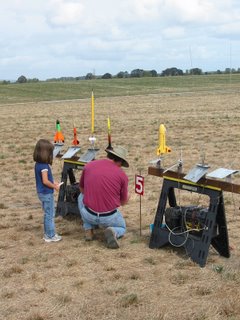
Here we see the fully loaded rack, waiting to fly. As you can see, the NSV isn't very big as model rockets go. In fact, the large white and pink (nothing Freudian here!) rocket is still what is considered "mid-power." "High power" rockets fly from a separate series of pads much further from the crowd line. They're out of sight to the right of the frame.
The first flight of the NSV was made using an Estes "C6-3" rocket motor. For a little motor, that's pretty big, a maximum of 3 pounds of thrust, and a burn time of 1.7 seconds. The "3" is the number of seconds in the coasting delay, which allows the rocket to reach maximum altitude before the parachute is deployed.
The C6-3 has an 18mm case diameter. The motor mount on the NSV was modified to use 24mm diameter motors, and therefore I had to use an adapter to use the smaller diameter engine.
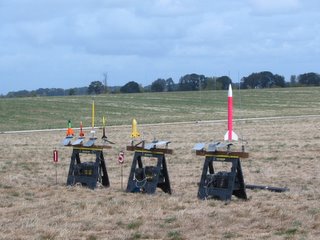
Here's the actual lift-off. As I said, I was a long way away from the pad, and I've pulled out a detail and magnified it so you can see what is happening.
The small, light-colored line pointing straight down from the rocket is actually flame from the motor exhaust. It doesn't look like much, but concentrated on one point, it's very intense. I've seen rockets hang up on the launch rod, and burn a hole in the sheet-steel blast deflector.
Model rocketry has an amazing safety record (you're probably in far more danger going to a Little League game, much less actually playing in one), but the potential for injury and property damage is always there. Organized launches like this follow strict safety rules.
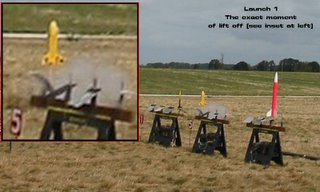
From this point, the rocket was moving too fast and high to follow with the camera. The flight was straight and near perfect. It actually got a lot more altitude out of the C6-3 than I had expected.
I did manage to pick it up with the camera after the recovery system had been deployed, though it wasn't much more than a speck in the sky. Again, there's an inset so you can actually see the rocket.
The nose cone separates from the rocket, and remains connected through a long, elastic, shock cord. A plastic parachute is connected to the nose cone, and (hopefully) slows the rocket for a soft landing.
To be honest, at this point, I had half expected that the cockpit had been ripped open and that Captain Lanard would be lost in the grass somewhere, never to be seen again. Fortunately, I'd built the cockpit well. The canopy remained in place, and Captain Lanard lives to fly another day.
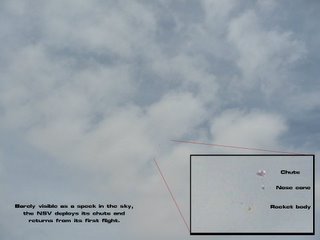
Here we see a posed, post-flight, victory wave. The parachute has already been packed back inside, and we've opened the cockpit so that Captain Lanard can take his bow.
Really, for me, this was an important part of the process. This wasn't some fake pilot head glued into a fake cockpit, as you sometimes see on model airplanes. This was a true action figure, able to be removed from his cockpit, played with and posed.
Encouraged by the success, I decided to pull out the 18mm motor adapter and fly on a more powerful 24mm motor. I chose an Estes D12-5. At a maximum of 6.4 pounds of thrust, this was a big step up from the "C" motor, and that changes a lot of things.
As I tried to explain to people over in the Sandbox recently, as they discussed the idea of building a working rocket pack for a 12" GI Joe, getting any rocket powered object to fly straight is -- well -- rocket science. Actually, for things that actually look like rockets, the rocket science doesn't have to be that hard. The general rules of thumb:
1. The longer (and to some extent, thinner) a rocket is, the more stable it is.
2. Weight in the front of the rocket (moving the center-of-gravity forward) makes a rocket more stable. Weight in the back of the rocket (moving the center-of-gravity backwards) makes a rocket less stable.
3. Fins behind the center-of-gravity make a rocket more stable. Fins in front of the center-of-gravity make it less stable. (Military guided missiles often have fins in the front because they use active, rather than passive stability systems like model rockets, and because instability makes it easy to turn on a dime when you need to, not a desirable characteristic for a model rocket).
The NSV has rule 1 working against it. It isn't long and thin, it's short and thick. Rule 2 is fairly good though, as the astronaut ads some weight to the front. Unfortunately, nose weight works better on long rockets, where it's way out in front and has lots of leverage. Not possible with the NSV. Rule 3 can be a problem too. It's easy to let the center of gravity slip so far back that part of the rear fins is actually on the wrong side of the CG.
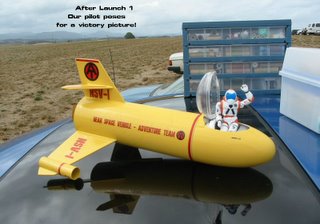 So, why are we talking about this when the NSV flew perfectly on it's first flight? Well, as I said, that big motor changes things. For one thing, it's much heavier. It shifts the center of gravity backwards, and on a short rocket, a little shift can make a big difference.
So, why are we talking about this when the NSV flew perfectly on it's first flight? Well, as I said, that big motor changes things. For one thing, it's much heavier. It shifts the center of gravity backwards, and on a short rocket, a little shift can make a big difference.Now on a simple rocket like the others you see in most of these shots, a rocket is pretty much either stable, or it isn't. But the NSV isn't a simple rocket. It's asymmetrical, what with the cockpit bubble, the fin-tip pods, the horizontal tail, the aerodynamics are suddenly dozens, maybe thousands of times more complicated. It's possible to have a rocket that's stable along one axis of rotation, and not along another. It's possible for stability to change under under other circumstances too, such as depending on the "angle-of-attack" at which it hits the oncoming air. Now we're getting into serious rocket science.
Mind you, the NSV did get tested before flight. I slung it around on a string. Seriously, that's an accepted test. You put a loop of string around the rocket, sling it in a circle around your head, and if it flies nose forward, it's theoretically stable. Along that one axis of rotation anyway. On a rocket like this, you rotate the rocket to multiple positions and retest each time. The test seemed to show was stable, even with the D motor. So off to the launch pad it went...
Now, here's some irony for you. The NSV project was inspired by the "Mercury Joe" program, an ongoing effort to launch high-power rockets with 12" GI Joe space capsules and astronauts on top. The launch vehicles are made to look like Redstone boosters, and the capsules are equipped with escape towers and multiple on-board video cameras. Wonderful stuff. If you haven't already, go visit the Vidroc site and watch their Mercury Joe videos. The Gumby rocket videos are also entertaining.
So anyway, it was interesting that I ended up on the pad next to a very nice scale model of a Mercury Redstone rocket.
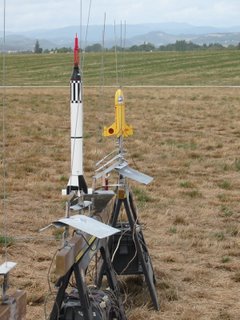 Here's a closer short of the NSV on the pad. You can see the astronaut and cockpit in launch position. One of my concerns in designing the rocket was that the acceleration is actually pushing the astronaut back into the canopy, and that this might pop it off from inside. I actually considered giving the astronaut his own, small, emergency chute in case he accidently "ejected," but I didn't have time. Fortunately, it was never an issue.
Here's a closer short of the NSV on the pad. You can see the astronaut and cockpit in launch position. One of my concerns in designing the rocket was that the acceleration is actually pushing the astronaut back into the canopy, and that this might pop it off from inside. I actually considered giving the astronaut his own, small, emergency chute in case he accidently "ejected," but I didn't have time. Fortunately, it was never an issue.But here we have yet more stability issues. Joe's off-center position throws the CG of the rocket off to one side, and as the rocket moves, he has enough room to shift around the cockpit, shifting the center of gravity on the fly. Now we need one of NASA's super-computers to know quite what is going on. Some things, you just have to try.
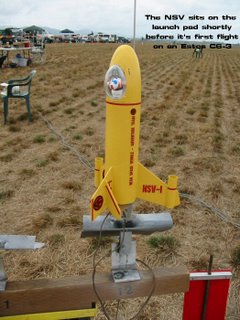
So here's what happened. Fortunately, the NSV wasn't completely unstable. If it had have been it could have looped and become a "cruise missile" headed for spectators, launch officials, or other rockets. Dangerous and embarrassing.
But it wasn't entirely stable either. Like I said, I think it had one "lobe" of insufficient stability. This cause the rocket to cork-screw its way into the air, wasting most of the increased thrust. In fact, I'd guess this D motor flight only went about 2/3s as high as the C motor flight, despite the increased thrust.
Fortunately, all ended well. As the motor burned, it became lighter. The rocket straightened out, and flew high enough to safely deploy its parachute and come to a safe landing (well, I think maybe we broke a fin, but it was an easy fix).
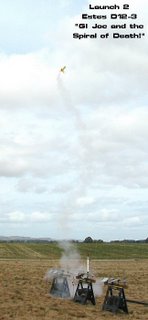
So, that was the end of that series of flights. The NSV returned the next year, repaired and improved, with a new Adventure Team astronaut (see previous posts) at the controls. Unfortunately, I was too busy flying to take many pictures that time, but the AT astronaut racked up several successful flights (though minor fin damage on landing continued to be a problem).
The NSV is in sad shape at the moment. It suffered some accidental damage here in my office, and needs major fin repairs. I'll do that eventually, but I'm thinking about retiring the rocket to static display. It's the fate of all rockets, it seems, that if you fly them long enough, either you lose them, or something eventually goes wrong. I'd like the NSV to survive long enough to serve as a reminder of its own glory days.
Now, that doesn't mean that we won't eventually build another Joe rocket...
No comments:
Post a Comment